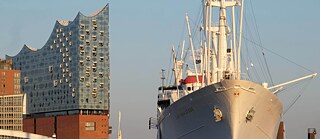Venice of the North
Hamburg is surrounded by water. The Alster river has been divided into two lakes that lie on either side of the city, the Binnenalster and Außenalster, and the River Elbe flows right through into the North Sea. All this water means an abundance of canals, streams and bridges. Hamburg has more bridges inside its city limits than any other city in the world and more canals than Amsterdam and Venice combined. The figure is somewhere around 2,300 to over 2,500.
Gateway to the World
Despite being located on the River Elbe, some 100 kilometers from the North Sea, Hamburg is a major port city. It has the country’s biggest port - the second-busiest in Europe and the third largest in the world. The port has been a hub of Germany’s trading activities for centuries and has helped Hamburg become one of Germany’s most affluent cities. Between 1850 and 1939, the port was the gateway to America for five million people from all over Europe.
Guten Appetit!
German immigrants to the US brought with them some of their favorite foods. One of them was Hamburg Steak. The Germans flavored shredded beef with regional spices, and both cooked and raw it became a standard meal. In Hamburg, it was called Hamburg Steak. Today, this hamburger patty is called “Frikadelle” or “Bulette.” Some people trace the origin of the hamburger to the Hamburg steak.
One Big Star Club
Tokio Hotel’s twin brothers Bill and Tom Kaulitz live and maintain a recording studio in Hamburg. Nena, famous for her song “99 Luftballons”, re-recorded in English as “99 Red Balloons”, enjoys being a grandmother in Hamburg. At the beginning of their careers, the Beatles played gigs in Hamburg’s St. Pauli neighborhood.
Germany's Sin City
St. Pauli is Europe’s largest red-light district. Hamburg’s most famous street, the “Reeperbahn”, the world’s “most sinful mile”, runs right through this entertainment district. This is also the home of FC St. Pauli, a soccer club whose fans like to party at their team’s home games. The club is popular all over Germany for having adopted an outspoken stance against racism and homophobia.
The Bundesliga Dinosaur
The Hamburger SV (HSV), founded in 1887, is Hamburg’s more traditional soccer club. It is Germany’s only team to have played in the Bundesliga in every season since the league’s formation in 1963. They have won the German championship six times and the European Cup in 1983. The HSV plays its home games at the Volksparkstadion with a capacity of more than 57,000.
Moin Moin!
60% of all Germans speak a dialect. The original language of Hamburg is Low German usually referred to as “Plattdeutsch”. It is a dialect that has been heavily influenced by the languages around it, namely English, Dutch, German, and Danish. A variety of Low German is still spoken by the Mennonite communities in Pennsylvania.
